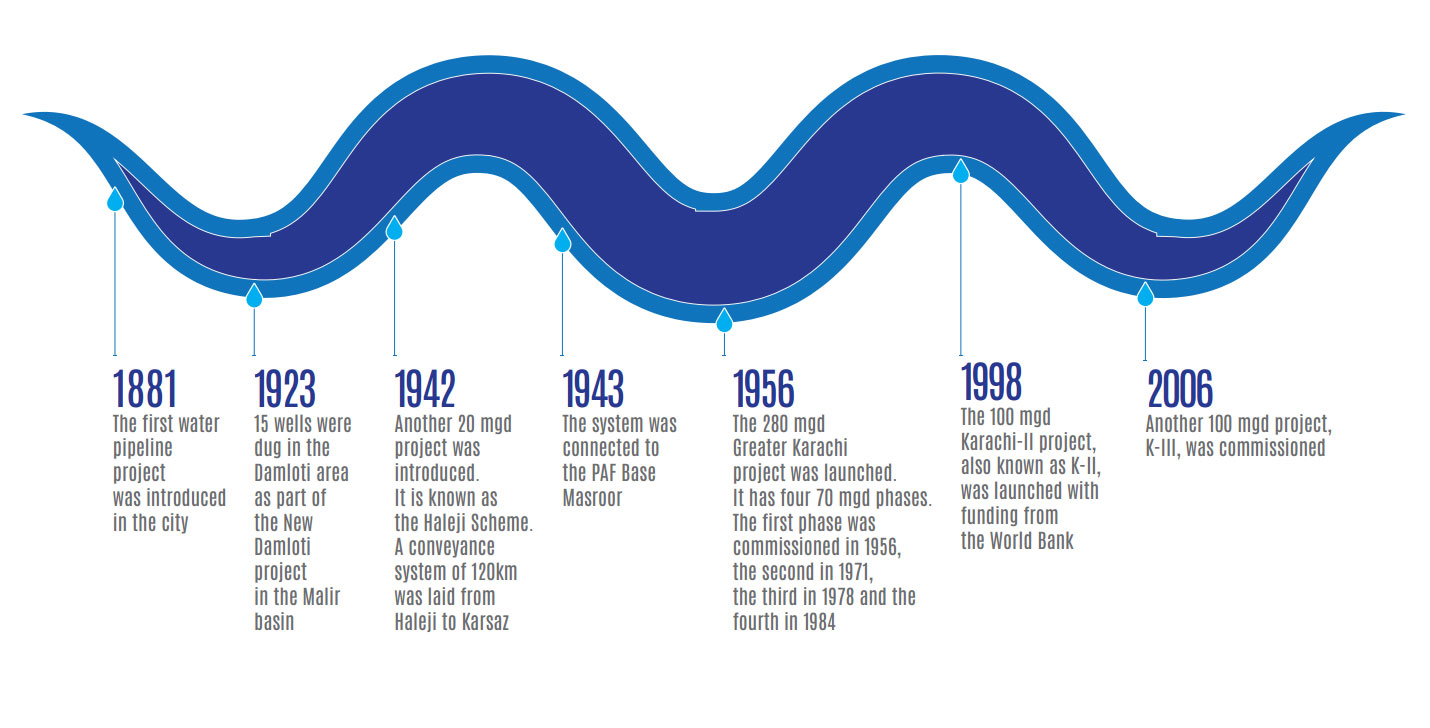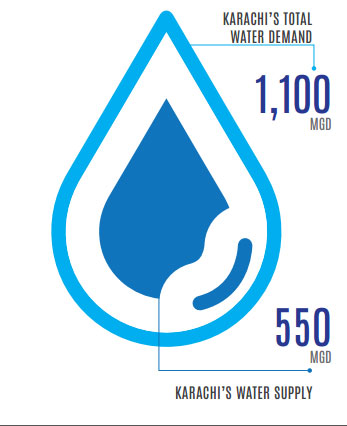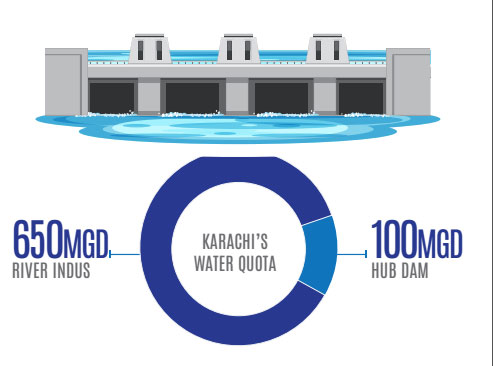A look at what’s being done for water-starved Karachi
Karachi’s total water demand is 1,100 million gallons per day (mgd), but only half of the requirement, 550 mgd, is being met by the city’s two water sources, the Hub Dam and the River Indus.
Different projects of the Government of Sindh that have been under construction for ages are expected to increase the water supply to 890 mgd — that is, if they ever see the light of day. And even after the completion of these projects, Karachi will still be short by 210 mgd.
It began in Damloti
The first water pipeline project to be introduced in the city was back in 1881. The 5 mgd project was introduced in District Malir’s Damloti area when Damloti was a well.
“People back then used to dig wells and extract water from it for their use,” Zafar Palijo, project director of the Karachi Water & Sewerage Board (KWSB), told The News.
In 1923, 15 wells were dug in the Damloti area as part of the New Damloti project in the Malir basin. Pumps were installed and a conveyance system of 28 kilometres was laid down until the Lines Area, which was the highest point of the city back then.
“It was 40 feet above sea level,” said Palijo, adding that there used to be offshoots from the Lines Area. The conveyance system carried water all the way to the city.
After 1942, another 20 mgd project was introduced. It is known as the Haleji Scheme. “Haleji is a natural depression in the Thatta district,” said the KWSB official. Its walls were raised and a reservoir was constructed. A conveyance system of 120km was laid from Haleji to Karsaz.
From Karsaz, this water project was raised to the high service reservoir at Pir Pagara Road near KDA Scheme 1. In 1943, this system was connected to the PAF Base Masroor.
In 1956, the 280 mgd Greater Karachi project was launched. It has four 70 mgd phases. The first phase was commissioned in 1956, the second in 1971, the third in 1978 and the fourth in 1984.
In 1998, the 100 mgd Karachi-II project, also known as K-II, was launched with funding from the World Bank. In 2006, another 100 mgd project, K-III, was commissioned.
River Indus quota
Karachi has a sanctioned quota of 650 mgd from the River Indus and of 100 mgd from the Hub Dam. “We are currently taking 500 mgd from the River Indus, so there is a gap of 150 mgd,” Palijo explained.
Out of the 650 mgd sanctioned quota for Karachi from the River Indus, 20 mgd goes to the Port Qasim and the Steel Mill, so “this is our balance water quota of 130 mgd that the city does not get”.
For this purpose, the government introduced two projects: a 65 mgd scheme that is fully funded by the provincial government, and another 65 mgd one that is to be constructed under public-private partnership.
The government-funded 65 mgd project has three components, and its revised PC-I has been approved. “Two components have already been awarded, while the last one will be awarded soon.”
The first component is from Haleji to the Gharo pumping station, which is a 20km segment in which a gravity canal will be constructed, and 30 per cent of its work is already done. “There is no pumping involved in the gravity system. The water flows at grade.”
The second component is of construction at Gharo that will bring the water towards the city. “Its tender is being processed,” the KWSB official pointed out.
The third component is the rising main: there will be an 11km pipe system from the pumping station. “There is a high point of the KWSB, which is known as IV Bay,” he said, adding that 16 per cent of it work has been completed. The IV Bay point is Dhabeji.
The other 65 mgd component will be constructed from the Gujo Headwork, which is a point in District Thatta, all the way to Dhabeji. The Gujo Headwork is a controlling regulator of water at a small river channel. The feasibility study of this project is under way.
From Dhabeji, water will be pumped to the IV Bay high point. From there, the two projects will supply 120 mgd to the city, while 10 mgd will be supplied to the economic zone near Dhabeji.
There will be a common system of 120 mgd that will bring water to the city “through different engineering structures that will have conduits, siphons and pipes”. Palijo said that these two projects will cover the balance quota of water from the River Indus to the city.
Hub Dam quota
The second source of water is the Hub Dam, whose beneficiaries are the Sindh and Balochistan governments. Their combined share is 159 mgd, out of which Karachi gets 63 per cent (100 mgd) and Balochistan 37 per cent (59 mgd).
The minimum level of water in the Hub Dam is 276 feet, and the maximum 339 feet. During the last monsoon season, the spillways of the dams were opened. “The dam has a capacity to hold water for three years.”
There is a 7km common canal for the 159 mgd that then bifurcates, with the Karachi canal measuring 22km until Manghopir that carries 100 mgd for the city.
From Manghopir, there are four offshoots, or water transmission system through four different lines, which supply water to District West. “All four of these are for District West because it is entirely dependent on the water supply from the Hub Dam.”
The system is also integrated. There is the North East Karachi pumping system near Maymar, through which a water stream supplies water to the Manghopir pumping station when the Hub Dam dries up.
This stream can carry 70 mgd. “Areas such as North Karachi, New Karachi and even District West get water from both sources, the Hub Dam and the River Indus,” explained Palijo.
As for the K-IV project, it is different from all the other schemes, with a capacity to supply 650 mgd. Its source, however, is the Keenjhar Lake, which is a part of the River Indus, but its system will be completely different. It has three phases: 260 mgd, 260 mgd and 130 mgd.
The underground PRC concrete water system of the KWSB was laid down in 1956. “Its lifetime is 30 years. The system is outdated now,” said the water board official.
In the WB’s Karachi Water & Sewerage Services Improvement Project (KWSSIP), a lot of water lines are being replaced with a new system. “The KWSSIP has a system upgrade component as well,” he said, adding that its feasibility studies are under way.
-
 Sophie Turner Gets Candid About 'imposter Sydrome' Post 'GOT'
Sophie Turner Gets Candid About 'imposter Sydrome' Post 'GOT' -
 When Nicola Peltz's Boyfriend Anwar Hadid Found Solace In Dua Lipa's Arms
When Nicola Peltz's Boyfriend Anwar Hadid Found Solace In Dua Lipa's Arms -
 Claire Foy Reveals Rare Impact Of 'The Crown' Gig On Career
Claire Foy Reveals Rare Impact Of 'The Crown' Gig On Career -
 Megan Thee Stallion Teases New Music On The Way
Megan Thee Stallion Teases New Music On The Way -
 Blonde Kate Stuns In Photos With Prince William During Rare Joint Engagement
Blonde Kate Stuns In Photos With Prince William During Rare Joint Engagement -
 Kate Gosselin Reveals Horrowing Moment Thief Nearly Took Her Down
Kate Gosselin Reveals Horrowing Moment Thief Nearly Took Her Down -
 Billy Bob Thornton Weighs In On Contrast To 'Landman' Role
Billy Bob Thornton Weighs In On Contrast To 'Landman' Role -
 Amanda Holden May Swap Position To Different Reality Show: See Which
Amanda Holden May Swap Position To Different Reality Show: See Which -
 The Truth Behind Victoria Beckham's 'inappropriate' Wedding Dance Video
The Truth Behind Victoria Beckham's 'inappropriate' Wedding Dance Video -
 AI Startup Raises $480 Million At $4.5 Billion Valuation In Earlier Gains
AI Startup Raises $480 Million At $4.5 Billion Valuation In Earlier Gains -
 North Carolina Woman Accused Of Serving Victims With Poisoned Drinks
North Carolina Woman Accused Of Serving Victims With Poisoned Drinks -
 Robert Redford’s Daughter Amy Sings Praises Of Late Father
Robert Redford’s Daughter Amy Sings Praises Of Late Father -
 OpenAI And ServiceNow Team Up To Embed ChatGPT In Business Workflows
OpenAI And ServiceNow Team Up To Embed ChatGPT In Business Workflows -
 Johnny Depp Prepares For His Massive Comeback After Years Of Struggle
Johnny Depp Prepares For His Massive Comeback After Years Of Struggle -
 Meghan Markle Is Ready To Put A Cork In It All By Giving Prince Harry Baby No. 3: ‘She Wants A Break’
Meghan Markle Is Ready To Put A Cork In It All By Giving Prince Harry Baby No. 3: ‘She Wants A Break’ -
 Billie Eilish Speaks Out Against Authority: 'It's Very Strange'
Billie Eilish Speaks Out Against Authority: 'It's Very Strange'






